Abstract
The molecular clusters ((HO)3Si-O-Si(OH)3 and (HO)3Al-O-Si(OH)3) representative of aluminosilicate mineral surface were employed to study the dissolution of aluminosilicate in acidic condition via density functional theory (DFT) with the M06-2X+G(d,p) methodology. The surface termination sites (Si and Al) were both tetra-coordinated and the terminal oxygen was protonated in an acidic condition. In the dissolution reaction, the calculated barrier height of the six-membered ring transition state complex containing two water molecules was predicted to be 76.13 kJ/mol, lower than that of the four-membered ring transition state complex containing one water molecule. The barrier height of the reaction decreased to 6.17 kJ/mol and was 91.90% lower than that for the Siter-O-Si without protonation. In addition, the calculated barrier heights for Al-terminated sites were predicted to be 22.23 kJ/mol, lower than those for the Si-terminated sites, suggesting that breaking the Al-O bond is easier than the Si-O bond in the aluminosilicate mineral surface. With the fracture of Si-O and Al-O bonds, the Si and Al release from the aluminosilicate. The results indicate that the acidic condition facilitates the release of Si and Al from the aluminosilicate, and the concentration of Al leaching from the aluminosilicate is higher than the Si.
1. Introduction
The dissolution of aluminosilicate minerals in an aqueous solution occurs nearly everywhere on Earth and has an effect on a number of processes such as soil chemistry, water contaminants, and the global CO2 cycle. Furthermore, investigating the dissolution mechanisms in an acidic condition will provide some implication for the acid activation of aluminosilicate minerals and energy saving. High sintering temperature is required in the porcelain industry as the destruction of Si-O and Al-O bonds of aluminosilicate minerals in the raw material needs high activation energy [], which results in high energy consumption. In order to decrease the energy consumption, methods for reducing sintering temperature are investigated. Activating the raw material can destroy the Si-O and Al-O bonds in the mineral and then reduce the sintering temperature []. Acid activation is a common activation method [,,] since the dissolution rate of the mineral increases in an acid aqueous solution. Aluminosilicate minerals (such as kaolin and feldspar) account for a large proportion in the raw ceramic material. It is therefore worth investigating the dissolution mechanism of aluminosilicate minerals. A. Steudel [] has reported that under acidic conditions, the dissolution rate of Si and Al from kaolin and feldspar increased significantly and a large number of Si-O and Al-O bonds in mineral are destructed.
The dissolution of minerals in aqueous solutions has been studied for nearly a century. Most authors have investigated the dissolution rate law of minerals based on the concentration of Si and Al released from minerals [,,]. However, the hydrolysis of minerals generally occurs in a number of steps rather than as written stoichiometrically. For example, orthoclase dissolution can be described thermodynamically by
KAlSi3O8 + 4H3O+ → K+ + Al3+ + 3H4SiO4
However, the probability of an orthoclase formula unit reacting with 4H3O+ molecules in one step is vanishingly small. Instead, the reaction occurs in a number of elementary steps, such as ion exchange of K+, the hydrolysis of individual Al-O-Si and Si-O-Si linkages, the formation of K+ and Al3+ species. Among these elementary steps, close attention has been paid to the breakage mechanisms of Al-O and Si-O bonds in the mineral surfaces. To investigate the reaction pathways, some scholars have simulated the Si-O and Al-O bond cleavage at the molecular level using quantum mechanical calculations in recent decades [,].
Theoretical studies have been carried out on the effect of different molecules on the clusters of (SiO)n, (AlO4)n or (Al/Si-O-Si)n [,,]. C. Zhang [] explored the stability of the Al-O/water system and Si-O/water system, using the Si-O layer (Si6O18H12) or Al-O layer (Al6O24H30) cluster model of kaolinite at the B3LYP. A. Rimola [] studied the ring opening reactions of (SiO)n ring motifs at silica surfaces by their interaction with H2O and HCOOH by means of quantum chemical methods, adopting the B3LYP-D2/6-311++G(d,p) level of calculations for computing the energetics of the reaction; the calculation shows that the energy barriers of the ring opening reactions with H2O is significantly lowered by the presence of an additional H2O molecule acting through the proton relay mechanism. However, the basic structure unit of aluminosilicate minerals was not presented and the effect of the proton was also not discussed in detail.
Two typical molecular clusters (Figure 1) on aluminosilicate mineral surface were chosen for calculation. The dotted line in Figure 1 represents the surface of the mineral, and each tetra-coordinated Si or Al is terminated with hydroxyl groups. Both the Si and Al terminal sites (Siter and Alter) are connected to the bulk of mineral by a bridge oxygen atom (Obri). Si sites on the surface is depicted by the Siter-O-Si to simulate the breakage of Siter-O bond and the release of Si. Similarly, the Al terminated sites is depicted with Alter-O-Si to indicate the breakage of Alter-O bond and the release of Al. The oxygen in the hydroxyl group attached to the Siter and Alte on the surface is called terminal oxygen.
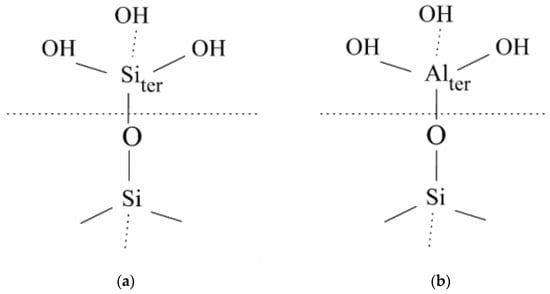
Figure 1.
Schematic of hydroxylated aluminosilicate mineral surface showing (a) Si and (b) Al terminal.
In the presence of an acidic aqueous solution, the H+ is easily captured by the terminal oxygen on the hydroxylated aluminosilicate mineral surface for the weak space steric effect. This study focuses on the reaction pathway for hydrolyzing Siter-O-Si and Alter-O-Si, and the effect of the proton on the breakage of Siter-O and Alter-O bonds. The reaction rate constants were calculated by the Arrhenius equation via the barrier height computed by data in the output file. Before the investigation of the barrier height for the Siter-O-Si and Alter-O-Si surface sites, the effect of the configuration of transition state complexes containing four- and six-membered rings (Figure 2) on the activation energy is discussed.
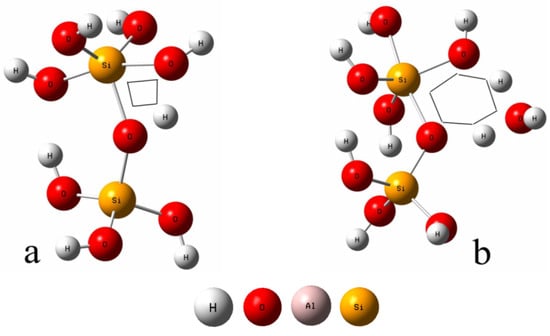
Figure 2.
Transition state complexes of Siter-O-Si reacting with H2O containing (a) four-membered and (b) six-membered ring.
2. Materials and Methods
2.1. Reaction Models
The most important aspect of a reaction pathway is determining the transition state complex, which has no stability in time and has no real finite concentration, by definition. Recent descriptions of quartz and aluminosilicate mineral dissolution included different transition state complexes during the hydrolysis of Al-O-Si and Si-O-Si linkage on the mineral surface [,]. However, the configurations of the transition state complexes were not discussed. In this paper, the four- and six-membered ring transition state complexes for the hydrolysis reaction of aluminosilicate are presented. The four-membered ring configuration contained an Si and O atom in the reaction center of Siter-O, and H and O from a water molecule (Figure 2a), whereas the addition of H and O from in the six-membered ring configuration (Figure 2b) came from another water molecule.
In the beginning of the hydrolysis reaction, the water molecule approached the reaction center and the coordination of Si and Al was changed from four to five. Then the Siter-O and Alter-O bonds lengthened and the coordination of Siter and Alter converted into four. Finally, the Si and Al species left away from the mineral surface and migrated to the liquid phase.
To model dissolution process for the surface reaction sites above, the following six reactions were studied. Equations (1) and (2) represent the Siter-O-Si (Figure 3a) and Alter-O-Si (Figure 3b) sites without protonated terminal oxygen, respectively. With the breakage of the Siter-O or Alter-O bond, the Si and Al species are extracted from the reaction sites as H4SiO4 and [Al(OH)4]−, respectively. Equations (3) and (4) represent the Siter-O-Si (Figure 4a), and Alter-O-Si (Figure 4b) sites with protonated terminal oxygen, respectively (Figure 3). After the hydrolysis reaction, the protonated monosilicic acid molecule releases from the Siter-O-Si, and the [Al(OH)3·H2O] forms from the Alter-O-Si site. The bridge oxygen in the surface sites becomes the terminal oxygen after reaction. The charge of the molecular cluster in the Equations (1)–(4) is retained during calculation.
[(HO)3Siter-O-Si(OH)3] + H2O → 2Si(OH)4
[(HO)3Alter-O-Si(OH)3]− + H2O → [Al(OH)4]− + Si(OH)4
[(H2O)(HO)2Siter-O-Si(OH)3]+ + H2O → [Si(OH)3H2O]+ + Si(OH)4
[(H2O)(HO)2Alter-O-Si(OH)3] + H2O → [Al(OH)3H2O] + Si(OH)4
[(H2O)(HO)2Siter-O-Si(OH)3]+ + 2 H2O → [Si(OH)3H2O]+ + Si(OH)4 + H2O
[(H2O)(HO)2Alter-O-Si(OH)3] + 2 H2O → [Al(OH)3H2O] + Si(OH)4 + H2O
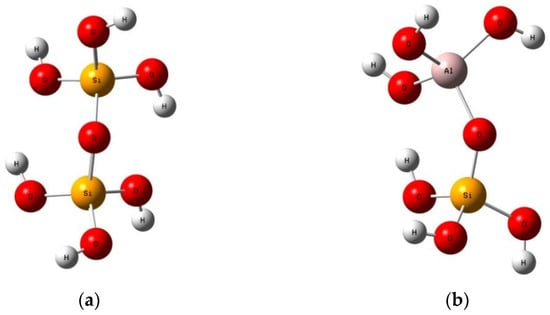
Figure 3.
The molecular clusters of (a) Siter-O-Si and (b) Alter-O-Si.
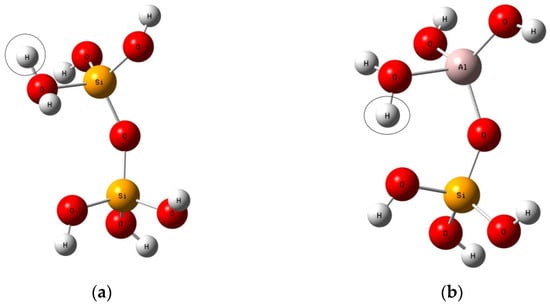
Figure 4.
The terminal oxygen in (a) Siter-O-Si and (b) Alter-O-Si before and after protonation.
2.2. Reaction Rate
Once the reactant and transition state has been optimized in the gas-phase (1 atm, 298 K) for each reaction, the frequency in output files is used to calculate the rate constant via the Arrhenius equation:
where is referred to as the pre-exponential factor, is the activation energy, is the gas constant and is the temperature in degrees Kelvin.
3. Computational Methods
Some articles have successfully applied the DFT method to explain the hydrolysis reaction of the silicate mineral surface [,,,]. Thus, the application of the M06-2X functional method [] here to model the hydrolysis of aluminosilicate is reasonable. In the dissolution process, the coordination number of the Si atom and the Al atom with d orbitals and p orbitals is altered; the H atom is important and calculated. Thus, the 6-311+G(d,p) basis set is employed in this study. All calculations were performed on the reactants, products and transition state complexes given in Equations (1)–(6) with the Gaussian 09 package [] without any constrains. The transition state was obtained by requiring that there was one and only one imaginary frequency for the configuration of the constructed cluster; otherwise, we readjusted or even redesigned the configuration to find the correct transition state configuration.
4. Results
The configurations of transition state complexes were firstly discussed. Then the hydrolysis mechanisms of Siter-O-Si and Alter-O-Si sites in an acidic condition were investigated.
4.1. The Configuration of Transition State
The hydrolysis process of Siter-O-Si with H2O is shown in Figure 5 and Figure 6, distinguished by the configuration of transition state complexes (Table 1). When the Siter-O-Si surface site reacted with a H2O molecule (Figure 5), the transition state complex contained a four-membered ring. Along the reaction path, the H in the water molecule was absorbed by the bridge O and the rest of water molecule (OH) was captured by the Siter, while simultaneously, the Siter-O bond fractured. The barrier height of this reaction (labelled as Rf) was 121.11 kJ/mol. When the Siter-O-Si surface site reacted with two H2O molecules (Figure 6), six-membered ring complexes of transition state formed. Along this reaction path, the H in the H2O beside the bridge O side bonded with the bridge O and the OH in the other H2O near the Siter was captured by the Siter. In addition, a new water molecule formed with the rest of H and OH from different H2O molecules. The barrier height of this reaction (labelled as Rs) was 76.13 kJ/mol.
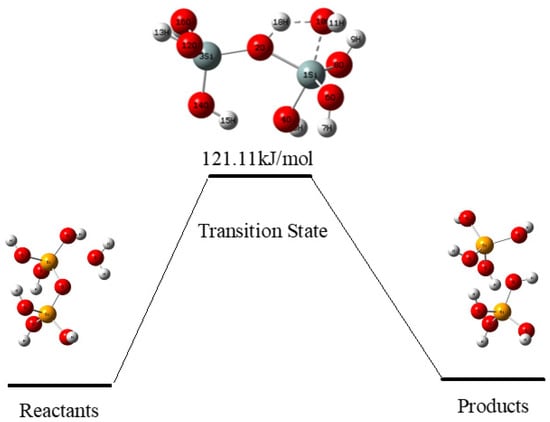
Figure 5.
Reaction mechanism for the hydrolysis of the Siter-O-Si site in the presence of a H2O molecule. The transition state complex contains a four-membered ring (TS4).
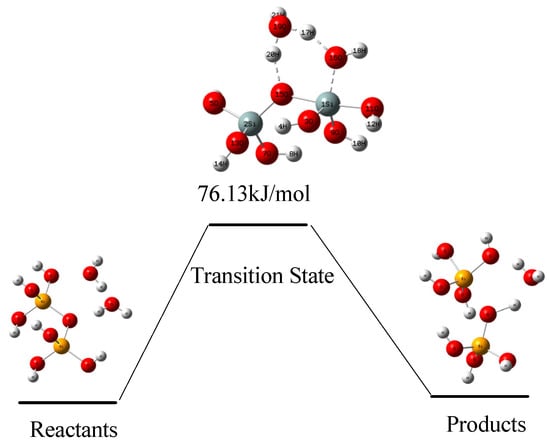
Figure 6.
Reaction mechanism for the hydrolysis of the Siter-O-Si site in the presence of two H2O molecules. The transition state complex contains a six-membered ring (TS6).

Table 1.
Selected geometry parameters of the transition state complex containing a four-membered ring (TS4) and a six-membered ring (TS6). Bond Lengths in Å, Bond Angles in Degrees.
According the Arrhenius equation, the rate constant of Rs was 7.60 × 107 time of the Rf. The addition of the H2O insignificantly affects the activation energies. The lower activation energy and larger rate constant of Rf is possibly attributed to the weaker bond strength of Siter-O in the reaction of the six-membered ring. Compared with the experimental data for the hydrolysis activation energy of quartz, only containing Si-O-Si site, which was 67~89 kJ/mol [,,], the barrier height of six-membered ring transition state was reasonable. Thus, the six-membered ring configuration of the transition state was appropriate and is used in the following text.
4.2. Hydrolysis Reaction at Siter-O-Si Site
The energy profiles of Siter-O-Si with protonated terminal oxygen reacting with two H2O molecules are shown in Figure 7 and Table 2. After the breakage of the Siter-O bond on the mineral surface, the Si species was left as [Si(OH)3(H2O)]. The barrier height of the reaction decreased to 6.17 kJ/mol and was 91.90% lower than that for the Siter-O-Si without protonation. The rate constant of this hydrolysis reaction was 1.81 × 1012 times of that of the Siter-O-Si without protonated terminal oxygen. The proton significantly affected the electron cloud of the terminal oxygen and the bond strength of Si-O, resulting in the lower barrier height. This indicated that the proton facilitates the fracture of the Siter-O bond on the mineral surface, corresponding to the experimental data that the dissolution rate of Si release from quartz and feldspar increased in the acidic condition [,].

Figure 7.
The reaction path of a protonated Siter-O-Si site.

Table 2.
Selected geometry parameters of the transition state of Siter-O-Si with protonated terminal oxygen reacting with two H2O molecules (TS6-1). Bond Lengths in Å, Bond Angles in Degrees.
4.3. Hydrolysis Reaction at Alter-O-Si Site
The energy profiles of hydrolysis reaction at Alter-O-Si site are shown in Figure 8 and Table 3. The barrier height for the Alter-O-Si without protonation was 22.23 kJ/mol. The results suggest that the Alter-O-Si site was easier to hydrolyze than the Siter-O-Si site. This may be attributed to the higher bond energy and symmetry of Siter-O-Si, which needed higher energy to break.
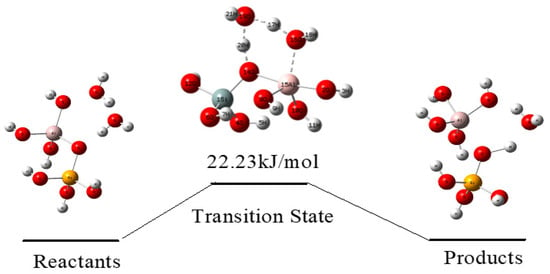
Figure 8.
The reaction path of Alter-O-Si site without protonated terminal oxygen.

Table 3.
Selected geometry parameters of the transition state of Alter-O-Si site (TS6-2) and Alter-O-Si site with protonated terminal oxygen reacting (TS6-3) with two H2O molecules. Bond Lengths in Å, Bond Angles in Degrees.
Figure 9 and Table 3 show the energy profile and hydrolysis mechanism of Alter-O-Si with protonated terminal oxygen. The barrier height was −0.86 kJ/mol. The negative activation energy suggested that the intermediate existed with a lower energy than the transition state []. The two reactants formed an intermediate with lower energy, due to the strong hydrogen bond before the transition state formed. These results led to the same conclusion, that the protonated site was easier to hydrolyze than the unprotonated site.

Figure 9.
The reaction path of Alter-O-Si site with protonated terminal oxygen.
Compared to barrier height for the hydrolysis of Siter-O-Si clusters, the barrier height for the hydrolysis of Alter-O-Si clusters was lower, due to the longer chemical bond of Alter-Obri, and the chemical bond strength was weakened. This implies that the Alter-O-Si site reacted more easily with H2O, which indicates the hydrolysis reaction may take place preferentially at the Alter-O-Si site on the aluminosilicate mineral.
5. Conclusions
The Siter-O-Si and Alter-O-Si clusters representative of aluminosilicate mineral surface were employed to study hydrolysis reactions in an acidic condition via density functional theory with the M06-2X+G(d,p) methodology. The transition state complex containing a six-membered ring for Siter-O-Si linkage yielded barrier heights of 76.13 kJ/mol, which was lower than 121.11 kJ/mol for the complex containing a four-membered ring and was closer to the experimental data of 67~89 kJ/mol for the hydrolysis activation energy of quartz.
In the hydrolysis reaction, the calculated barrier heights of Siter-O-Si and Alter-O-Si clusters without protonated terminal oxygen molecule were 76.13 and 22.23 kJ/mol, respectively; the calculated barrier heights of Siter-O-Si, and Alter-O-Si clusters with protonated terminal oxygen molecule were 6.71 and −0.86 kJ/mol, respectively. It was obvious that the barrier height decreased as the terminal oxygen was protonated and the hydrolysis activation energy of Alter-O was lower than that of Siter-O before and after protonation. The barrier height of the three surface sites was ranged as: Alter-O-Si < Siter-O-Si. With the fracture of the Siter-O and Alter-O bonds, the Si and Al were released from the aluminosilicate. These results confirm that the proton facilitates the release of Si and Al, and the dissolution of Al was easier than Si in the aluminosilicate mineral surface.
Author Contributions
Conceptualization, C.-Y.Z.; methodology, H.Y.; software, L.-M.W.; validation, Y.-L.Y.; formal analysis, M.-F.Z.; investigation, Y.-L.Y.; resources, H.Y. and W.X.; data curation, Y.-Y.W.; writing—original draft preparation, C.-Y.Z., S.-M.L.; writing—review and editing, Y.L., C.-Y.Z. and L.-M.W.; visualization, Z.-J.Z.; supervision, S.-M.L.; project administration, S.-M.L. and; funding acquisition, Y.-L.Y. and Z.-J.Z. All authors have read and agreed to the published version of the manuscript.
Funding
This research was funded by the National Natural Science Foundation of China (Nos. 21207027 and 51372090), the Science and Technology Planning Project of Guangdong Province (No. 2017B090921002), the Scientific Research Project of the Department of Education of Guangdong Province (2022KQNCX046) and the Science and Technology Planning Project of Chaozhou (2021ZC29).
Institutional Review Board Statement
Not applicable.
Informed Consent Statement
Not applicable.
Data Availability Statement
Not applicable.
Acknowledgments
The innovative research team of advanced ceramic materials at Hanshan Normal University, the Chaozhou Branch of Chemistry and Chemical Engineering Guangdong Laboratory and the Guangdong Chaoshan Institute of Higher Education and Technology are all acknowledged.
Conflicts of Interest
The authors declare no conflict of interest.
References
- Huggins, M.L.; Sun, K.-H. Energy Additivity in Oxygen-containing Crystals and Glasses. J. Phys. Chem. 1946, 50, 319–328. [Google Scholar] [CrossRef]
- Zhang, C.; Zhang, Z.; Tan, Y.; Zhong, M. The Effect of Citric Acid on the Kaolin Activation and Mullite Formation. Ceram. Int. 2017, 43, 1466–1471. [Google Scholar] [CrossRef]
- Czech, K.; Banaś, D.; Kubala-Kukuś, A.; Stabrawa, I. The effect of chemical modification on the physico-chemical characteristics of halloysite: FTIR, XRF, and XRD studies. J. Mol. Struct. 2015, 1084, 16–22. [Google Scholar]
- Chaari, I.; Medhioub, M.; Jamoussi, F.; Hamzaoui, A.H. Acid-treated clay materials (Southwestern Tunisia) for removing sodium leuco-vat dye: Characterization, adsorption study and activation mechanism. J. Mol. Struct. 2020, 1223, 128944. [Google Scholar] [CrossRef]
- Lin, S.L.; Yu, Y.L.; Zhang, Z.J.; Zhang, C.Y.; Zhong, M.F.; Wang, L.M.; Lu, S.X.; Xu, W.; Li, N.; Huang, X. The synergistic mechanisms of citric acid and oxalic acid on the rapid dissolution of kaolinite. Appl. Clay Sci. 2020, 196, 105756. [Google Scholar] [CrossRef]
- Steudel, A.; Batenburg, L.F.; Fischer, H.R.; Weidler, P.G.; Emmerich, K. Alteration of Non-Swelling Clay Minerals and Magadiite by Acid Activation. Appl. Clay Sci. 2009, 44, 95–104. [Google Scholar] [CrossRef]
- Franklin, S.P.; Hajash, A.; Dewers, T.A.; Tieh, T.T. The Role of Carboxylic Acids in Albite and Quartz Dissolution: An Experimental Study under Diagenetic Conditions. Geochim. Cosmochim. Acta 1994, 58, 4259–4279. [Google Scholar] [CrossRef]
- Cama, J.; Ganor, J. The Effects of Organic Acids on the Dissolution of Silicate Minerals—A Case Study of Oxalate Catalysis of Kaolinite Dissolution. Geochim. Cosmochim. Acta 2006, 70, 2191–2209. [Google Scholar] [CrossRef]
- Stillings, L.L.; Drever, J.I.; Brantley, S.L.; Sun, Y.T.; Oxburgh, R. Rates of Feldspar Dissolution at pH 3–7 With 0–8 mM Oxalic Acid. Chem. Geol. 1996, 132, 79–89. [Google Scholar] [CrossRef]
- Shikha, N.; Barbara, J.G. Reaction Rates and Dissolution Mechanisms of Quartz as a Function of pH. J. Phys. Chem. A 2008, 112, 2027–2033. [Google Scholar]
- Inna, K.; Andreas, L. Kinetic Monte Carlo Simulations of Silicate Dissolution: Model Complexity and Parametrization. J. Phys. Chem. A 2013, 117, 24894–24906. [Google Scholar]
- Song, K.; Wang, X.; Qian, P.; Zhang, C.; Zhang, Q. Theoretical study of interaction of formamide with kaolinite. Comput. Theor. Chem. 2013, 1020, 72–80. [Google Scholar] [CrossRef]
- Du, M.; Kolchin, A.; Cheng, H. Hydrolysis of a two-membered silica ring on the amorphous silica surface. J. Chem. Phy. 2004, 120, 1044–1054. [Google Scholar] [CrossRef]
- Majid, V.; Alireza, F. DFT investigations for “Fischer” esterification mechanism over silica-propyl-SO3H catalyst: Is the reaction reversible? Comput. Theor. Chem. 2015, 1071, 27–32. [Google Scholar]
- Zhang, C.; Qi, Y.; Qian, P.; Zhong, M.; Wang, L.; Yin, H. Quantum chemical study of the adsorption of water molecules on kaolinite surfaces. Comput. Theor. Chem. 2014, 1046, 10–19. [Google Scholar] [CrossRef]
- Albert, R.; Piero, U.; Mariona, S. Strained Ring Motif at Silica Surfaces: A Quantum Mechanical Study of their Reactivity towards Protic Molecules. Comput. Theor. Chem. 2015, 1074, 168–177. [Google Scholar]
- Christin, P.M.; Shikha, N.; Barbara, J.G. Ab Initio Investigation of Dissolution Mechanisms in Aluminosilicate Minerals. J. Phys. Chem. A 2009, 113, 1343–1352. [Google Scholar]
- Criscenti, L.J.; Kubicki, J.D.; Brantley, S.L. Silicate Glass and Mineral Dissolution: Calculated Reaction Paths and Activation Energies for Hydrolysis of a Q3 Si by H3O+ Using Ab Initio Methods. J. Phys. Chem. A 2006, 110, 198–206. [Google Scholar] [CrossRef]
- Civalleri, B.; Garrone, E.; Ugliengo, P. Ab Initio Study of the Adducts of Small Molecules with the Isolated Hydroxyl of Silica and the Bronsted Site in Zeolites: A Comparison between B3LYP and MP2 Methods. J. Phys. Chem. B 1998, 102, 2373–2382. [Google Scholar] [CrossRef]
- Xiao, Y.T.; Lasaga, A.C. Ab-initio Quantum-mechanical Studies of the Kinetics and Mechanisms of Silicate Dissolution: H+(H3O+) Catalysis. Geochim. Cosmochim. Acta 1994, 58, 5379–5400. [Google Scholar] [CrossRef]
- Felipe, M.A.; Kubicki, J.D.; Rye, D.M. Hydrogen Isotope Exchange Kinetics between H2O and H4SiO4 From Ab Initio Calculations. Geochim. Cosmochim. Acta 2003, 67, 1259–1276. [Google Scholar] [CrossRef]
- Zhao, Y.; Truhlar, D.G. The M06 Suite of Density Functionals for Main Group Thermochemistry, Thermochemical Kinetics, Noncovalent Interactions, Excited States, and Transition Elements: Two New Functionals and Systematic Testing of Four M06-class Functionals and 12 Other Functionals. Theor. Chem. Acc. 2008, 120, 215–241. [Google Scholar]
- Frisch, M.J.; Trucks, G.W.; Schlegel, H.B.; Scuseria, G.E.; Robb, M.A.; Cheeseman, J.R.; Scalmani, G.; Barone, V.; Mennucci, B.; Petersson, G.A.; et al. Gaussian 09; Revision, D.01; Gaussian, Inc.: Wallingford, UK, 2009. [Google Scholar]
- Casey, W.H.; Lasaga, A.C.; Gibbs, G.V. Mechanisms of Silica Dissolution as Inferred from the Kinetic Isotope Effect. Geochim. Cosmochim. Acta 1990, 12, 3369–3378. [Google Scholar] [CrossRef]
- Polster, W.; Barnes, H.L. Kinetics of Quartz Precipitation and Dissolution under Hydrothermal Conditions at 100 to 300 °C. GSA Abstr. Prog. 1992, 24, A206. [Google Scholar]
- Bird, G.; Boon, J.; Stone, T. Silica Transport during Steam Injection into Oil Sands: 1. Dissolution and Precipitation Kinetics of Quartz: New Results and Review of Existing Data. Chem. Geol. 1986, 54, 69–80. [Google Scholar] [CrossRef]
- Welch, S.A.; Ullman, W.J. Feldspar Dissolution in Acidic and Organic Solutions: Compositional and pH Dependence of Dissolution Rate. Geochim. Cosmochim. Acta 1996, 60, 2939–2948. [Google Scholar] [CrossRef]
- Steudel, A.; Batenburg, L.F.; Fischer, H.R.; Weidler, P.G.; Emmerich, K. Alteration of Swelling Clay Minerals and Magadiite by Acid Activation. Appl. Clay Sci. 2009, 44, 105–115. [Google Scholar] [CrossRef]
- Wu, R.; Wang, S.; Wang, L. New Mechanism for the Atmospheric Oxidation of Dimethyl Sulfide. The Importance of Intramolecular Hydrogen Shift in a CH3SCH2OO Radical. Phys. Chem. 2015, 119, 112–117. [Google Scholar] [CrossRef]
Publisher’s Note: MDPI stays neutral with regard to jurisdictional claims in published maps and institutional affiliations. |
© 2022 by the authors. Licensee MDPI, Basel, Switzerland. This article is an open access article distributed under the terms and conditions of the Creative Commons Attribution (CC BY) license (https://creativecommons.org/licenses/by/4.0/).